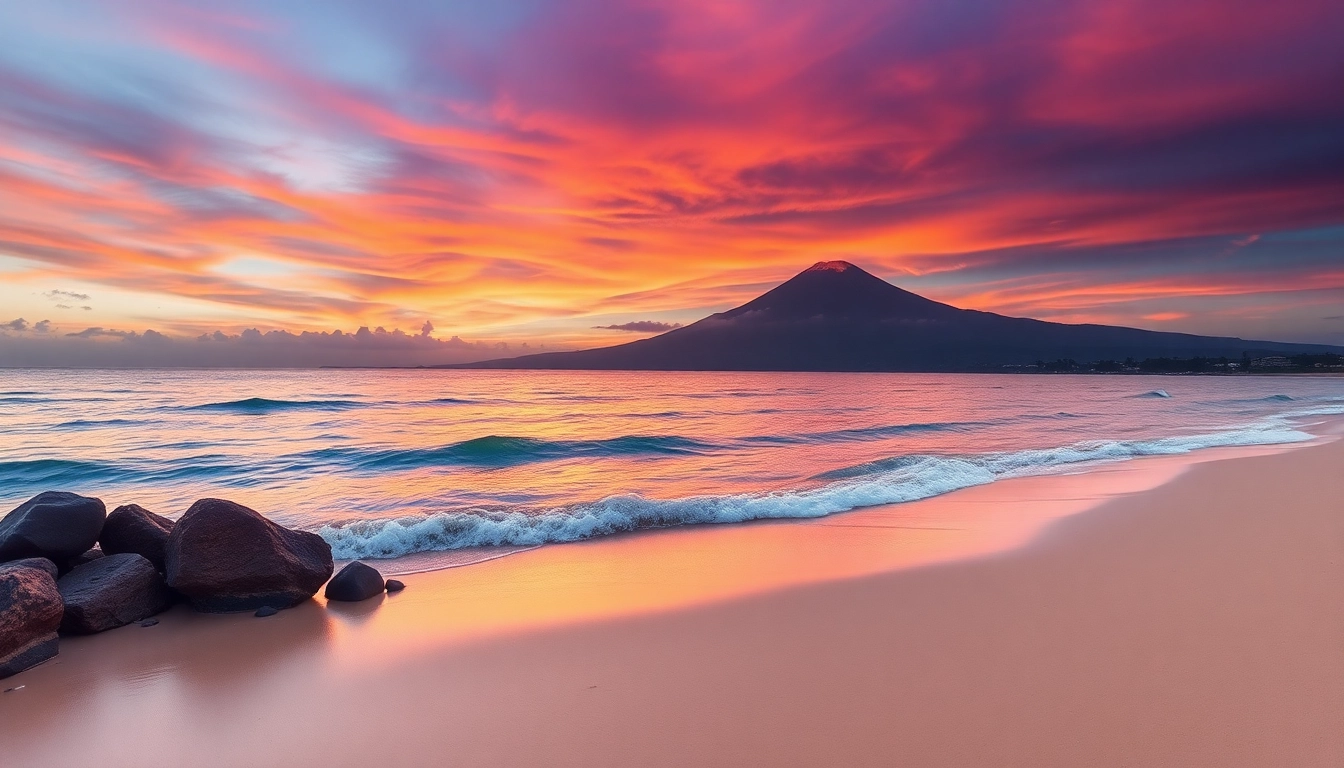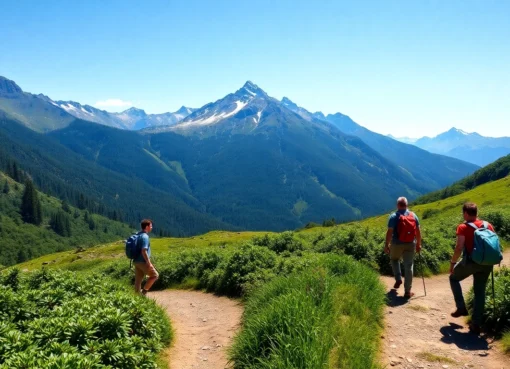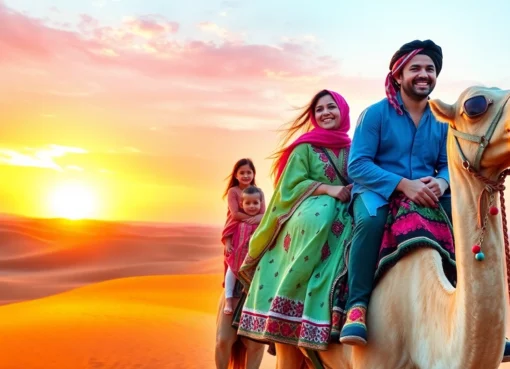Discover Lombok: A Guide to Indonesia’s Beautiful Island Paradise

Understanding Lombok: Geography and Cultural Heritage
Location and Geographical Features of Lombok
Nestled in the heart of Indonesia’s Lesser Sunda Islands, Lombok is a captivating island that boasts diverse geographical landscapes. Covering an area of approximately 4,738 square kilometers, Lombok is situated to the east of Bali and separated by the Lombok Strait, which is a vital waterway connecting the Bali Sea to the Indian Ocean. Its strategic location places Lombok in a unique position to offer both lush tropical environments and dramatic volcanic terrains.
The island’s topography is characterized by a central volcanic mountain range, with Mount Rinjani rising majestically to 3,726 meters—the second-highest volcano in Indonesia and a prominent feature that dominates the northern part of the island. Rinjani’s caldera system spans over 16 kilometers in diameter, hosting a crater lake known as Segara Anak, which adds to the scenic grandeur and attracts countless trekkers annually.
Lombok’s coastline is lined with pristine beaches, turquoise waters, and coral reefs that make it an ideal location for marine activities. The southern shores feature beaches like Tanjung Aan and Kuta Beach, renowned for their white sands, while the western coast offers surf-ready waves at spots like Senggigi and Gerupuk.
The island also includes several internal waterways, waterfalls, and rainforests, supporting rich biodiversity and sustaining traditional agriculture. Its geographical features contribute significantly to its economic activities, especially agriculture, fishing, and tourism.
The Rich Cultural Traditions of Lombok’s People
Lombok’s vibrant cultural identity is profoundly rooted in its indigenous Sasak community, which accounts for the majority of the population. The Sasak people have maintained their unique traditions, craftwork, and spiritual practices, which continue to thrive amidst modernization.
Traditional Sasak culture is showcased through distinctive customs such as traditional clothing, music, dance, and ritual ceremonies. One prominent example is the “Gendang Beleq” performance—an energetic drum and dance tradition performed during festivals and communal events that evoke a deep sense of communal identity.
The island’s cultural landscape is also marked by its unique architectural styles, notably the traditional Sasak houses called “Lumbung,” characterized by their distinctive thatched roofs and open layouts. These structures reflect the community’s deep connection to nature and social harmony.
Moreover, religious practices predominantly follow Islam, which influences daily life, rituals, and festivities. The communal prayers, festivals, and local ceremonies are vibrant expressions of faith that intertwine with age-old traditions. Notably, the colorful and intricate “Bau Nyale” festival celebrates the harvesting of sea worms believed to be the reincarnation of Princess Mandalika, a local legend symbolizing purity and fertility.
Through preserving their cultural heritage, the Sasak people offer visitors an authentic experience rooted in tradition, spirituality, and resilience.
Major Regions and Tourist Zones in Lombok
Lombok is conventionally divided into several key regions, each offering distinct attractions and experiences. These regions are primarily categorized as Lombok West, Central, East, and North, along with smaller islands and islands groups such as the Gili Islands.
- Lombok West: The most developed tourist area, featuring the popular Senggigi Beach, lively markets, vibrant nightlife, and luxurious resorts. Senggigi serves as a gateway for exploring nearby marine parks, diving spots, and cultural sites.
- Lombok Central: Known for the majestic Mount Rinjani and the surrounding national park, this region appeals to adventure seekers and eco-tourists. The traditional village of Sembalun offers scenic trekking routes and agricultural tours.
- Lombok East: Rich in traditional Sasak culture, the East includes remote villages and the busy town of Selong, near the eastern beaches like Mawun and Tanjung A’an. It’s an excellent area for exploring authentic local life and pristine beaches.
- Lombok North: The northern coast houses the port town of Bangsal and the Gili Islands—Gili Trawangan, Gili Meno, and Gili Air—which are renowned for their vibrant underwater life, vibrant nightlife, and laid-back atmospheres.
Each region presents its unique charm, making Lombok a versatile destination suitable for adventure, cultural immersion, relaxation, and eco-tourism.
Top Attractions and Natural Wonders of Lombok
Iconic Beaches and Surf Spots on Lombok
Lombok’s beaches are universally acclaimed for their natural beauty and superb conditions for water sports. Gili Trawangan, the largest of the Gili Islands, is celebrated for its lively atmosphere, snorkeling, and scuba diving opportunities, offering vibrant coral reefs teeming with marine life. Gili Air and Gili Meno provide a more tranquil environment suitable for visitors seeking relaxation and underwater exploration.
The southern beaches such as Kuta Beach and Tanjung Aan are known for their powdery white sands and excellent surf conditions. Kuta Lombok, in particular, has emerged as a premier surf destination, rivaling Bali’s iconic spots like Uluwatu. The consistent waves and warm waters attract surfers of all levels, supported by surf schools and sustainable surf tourism initiatives.
Beyond leisure, these beaches contribute significantly to local economies, encouraging eco-friendly tourism practices and conservation efforts to preserve marine biodiversity.
Mount Rinjani: Indonesia’s Active Volcano and Trekking Magnet
Standing tall at 3,726 meters, Mount Rinjani is not only Indonesia’s second-highest volcano but also a cultural and natural icon of Lombok. Its impressive crater lake, Segara Anak, provides a breathtaking setting for mandatory treks that attract thousands of adventure tourists each year.
Trekking Rinjani involves a multi-day ascent, often starting from Sembalun or Senaru, both equipped with trekking facilities and guides. The journey offers panoramic views, diverse ecosystems, and insights into the volcanic activity shaping the island’s landscape. The Rinjani Trek is considered one of the most rewarding experiences in Indonesia, combining physical challenge with spectacular scenery.
The national park around Rinjani also safeguards unique flora and fauna, including endangered species such as the Rinjani fig tree and the Crested Ibis. Sustainable trekking, guided tours, and eco-tourism initiatives are crucial to preserving this natural wonder.
Hidden Waterfalls and Primitive Forests of Lombok
For travelers seeking off-the-beaten-path adventures, Lombok offers an array of secret waterfalls and pristine forests. Air Terjun Sendang Gile and Tiu Kelep, located near the foothills of Rinjani, are some of the most accessible and picturesque cascading waterfalls, often visited together in volcanic rain forest settings.
Further inland, the forests of North Lombok and the lush terrain of Mount Rinjani’s national park conceal numerous smaller waterfalls and natural pools—ideal for trekking, swimming, and photography. Trails through this pristine wilderness provide insight into Lombok’s biodiversity and ecological importance.
Eco-driven tourism initiatives focus on conservation and sustainable access, ensuring that these natural assets remain preserved for future generations while supporting local community livelihood.
Adventure and Ecotourism in Lombok
Water Sports and Marine Activities for Visitors
Lombok’s surrounding waters are a playground for water enthusiasts. Snorkeling and scuba diving at marine parks like Gili Trawangan and the Sekotong Peninsula allow visitors to explore vibrant coral gardens and encounter diverse marine species, including manta rays and sea turtles.
Surfing is arguably the island’s most iconic activity, with world-class waves on the southern and western shores suitable for beginners through experts, supported by numerous surf schools that emphasize sustainability and reef protection.
Other marine activities include stand-up paddleboarding, kayak excursions, and island-hopping tours to nearby Gili Islands, ensuring a comprehensive aquatic adventure experience.
Hiking, Trekking, and Climbing Experiences
Beyond Rinjani, Lombok offers a variety of trekking options through rice terraces, forests, and traditional villages. The trek from Sendang Gile to Tiu Kelep Waterfalls is a popular half-day adventure, suitable for families and casual hikers.
For the more ambitious, the ascent of Mount Rinjani involves multiple days but offers spectacular vistas, volcanic lakes, and campsites that create a memorable mountain adventure. Guided eco-tours focus on minimizing environmental impact and supporting local communities.
Climbing expeditions further develop awareness of volcanic activity, geological processes, and conservation, with trained guides taking safety and sustainability into account.
Wildlife Conservation and Eco-Resorts on Lombok
Environmental conservation is central to Lombok’s ecotourism efforts. Several eco-resorts and conservation projects prioritize sustainable practices, such as waste management, renewable energy, and community involvement. These initiatives promote eco-friendly accommodations that blend with natural surroundings while supporting biodiversity.
The island hosts wildlife conservation programs for sea turtles, in protected nesting sites along beaches like Kuta and Senggigi. Visitors can participate in turtle releases and habitat restoration.
Eco-tourism fosters sustainable livelihoods for local populations, reducing reliance on destructive practices and encouraging preservation of Lombok’s natural and cultural heritage.
Experiencing Lombok’s Culture and Local Life
Traditional Sasak Villages and Crafts
A visit to Lombok would be incomplete without experiencing its authentic Sasak culture. Several traditional villages, including Sade and Sukarara, showcase unique architecture, weaving techniques, and daily routines of the indigenous Sasak people.
In Sukarara, visitors can observe and participate in traditional weaving, a craft passed down through generations, producing textiles like Songket and ikat fabric. Sade offers insights into traditional housing, ceremonies, and agricultural practices.
These villages are focal points for cultural preservation and provide meaningful engagement with local artisans. Visitors also have the opportunity to purchase handcrafted souvenirs and learn about Sasak’s rich textile and craft heritage.
Culinary Delights and Local Markets
Lombok’s cuisine reflects a blend of traditional spices, fresh seafood, and locally grown ingredients. Dishes like Ayam Taliwang—a spicy grilled chicken—and Plecing Kangkung—a vegetable salad with chili—highlight the island’s bold flavors.
Local markets such as Mataram’s Cakranegara Market and Senggigi Night Market offer an array of fresh produce, street foods, and artisanal products. Sampling satay fish, banana chips, and traditional desserts provides an authentic taste of Lombok’s culinary scene.
Food tourism also emphasizes sustainable sourcing and supporting local farmers and producers, aligning with eco-tourism principles.
Festivals and Cultural Events Celebrated in Lombok
Cultural festivals are integral to Lombok’s social fabric. The Bau Nyale Festival, celebrated annually, involves fragmenting legends into vibrant parades, traditional dancing, and the capture of sea worms—symbolic of Princess Mandalika’s reincarnation.
Other events include Islamic religious festivities, local wedding ceremonies, and harvest festivals. These gatherings are marked by music, dance, traditional attire, and community participation, providing tourists with immersive cultural experiences.
Participating in or observing these festivals offers deep insight into the spiritual and communal life of Lombok’s inhabitants, fostering mutual respect and cultural exchange.
Planning Your Trip to Lombok: Tips and Practical Guide
Best Time to Visit and Seasonal Highlights
The optimal visiting period for Lombok is during the dry season, which runs from May to September. During these months, visitors enjoy sunny weather, calm seas, and excellent conditions for outdoor activities like trekking, surfing, and diving.
The shoulder months of April and October also offer favorable weather with fewer crowds, making them ideal for budget-conscious travelers.
The rainy season, extending from November to April, can be characterized by tropical showers, but it also brings lush landscapes and fewer tourists, suitable for those seeking solitude.
Travel Options, Visa, and Accommodation Tips
Traveling to Lombok is convenient via Lombok International Airport (LOP), which handles both domestic and limited international flights. From the airport, transportation options include taxis, private drivers, and shared shuttles to various destinations around the island.
Visitors from many countries can obtain a visa on arrival or visa-free entry for stays up to 30 days, but it’s advisable to check current regulations before travel.
Accommodation options range from luxury resorts and boutique hotels in Senggigi and Kuta to budget guesthouses and eco-lodges in remote villages. For a more immersive experience, consider staying in eco-resorts that prioritize sustainability and local engagement.
Environmental Responsibility and Sustainable Tourism in Lombok
As tourism grows, so does the importance of environmental stewardship. Visitors are encouraged to practice responsible tourism by minimizing plastic use, avoiding coral damage, and respecting local customs.
Sustainable initiatives, including marine protected areas, waste management programs, and eco-tourism certifications, are gaining momentum. Tourists can support local communities by choosing eco-friendly tours, buying handmade crafts, and engaging with conservation projects.
Traveling consciously ensures that Lombok’s natural beauty and cultural integrity are preserved, benefiting local ecosystems, communities, and future generations.

